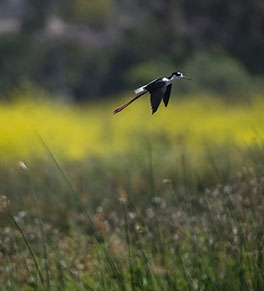UCI Health — Irvine embraces nature's bounty for the enjoyment of all

Stretching alongside UCI Health — Irvine and visible from most areas around the new hospital is the living, breathing San Joaquin Marsh Reserve.
As the flood plain of San Diego Creek, the protected wetlands and wildlife sanctuary filters upstream runoff across 300 acres of bulrushes and other vegetation, where it is cleansed before flowing into Upper Newport Bay and out to the ocean.
Viewed as a vital companion to the new acute care hospital and the entire 1.2 million-square-foot medical campus in Irvine, the marsh and its protection became a critical design and construction goal.
“We decided early on that we would not turn our back on the San Joaquin Marsh,” says Paul E. Da Veiga, director of planning, design and construction at UCI Health.
“We wanted it to be part of the fabric of the entire medical campus.”
Vast wildlife habitat
 The San Joaquin Marsh Reserve has long been an important habitat for local wildlife, including the native Western pond turtle, a species of concern in the state, and more than 300 species of birds.
The San Joaquin Marsh Reserve has long been an important habitat for local wildlife, including the native Western pond turtle, a species of concern in the state, and more than 300 species of birds.
About 100 of those avian species use the thriving wetlands as a stopping place on the Pacific Flyway, one of four major U.S. bird migration routes.
Canada geese, mallards,, cinnamon teals and ruddy ducks are permanent marsh residents and raise their young there. Migratory visitors include American white pelicans, Western tanagers, Swainson’s hawks and a variety of songbirds.
Protections for the sanctuary's flora and fauna built into the medical campus design include:
- Patterns on glass windows to create a distraction that prevents bird strikes.
- A 2-foot-tall barrier to block the marsh's turtles from climbing the slope leading up to the medical center.
- A stormwater capture network feeds into a biofiltration system to clean runoff before it reaches the reserve, ensuring a healthy marsh habitat.
- A 150-foot plant buffer between the marsh and medical center consists of native plant species using seeds harvested from the immediate marsh area.
Viewing the marsh
Almost as important as protecting the marsh was designing the medical campus to ensure its visibility so that everyone could feel nature’s healing effects. Design elements include:
- Expansive marsh views from a central plaza offer an impactful welcome.
- Most patient rooms have at least a partial view of the marsh through large floor-to-ceiling windows.
- The flat, easy-to-navigate campus design invites patients, visitors and co-workers to stroll outdoors for fresh air and the scents of nature.
- Waiting areas with large windows frame the marsh, providing a sense of calm.
- The café, located on the new hospital’s second floor, overlooks the marsh, offering views from indoor eating areas as well as an outdoor dining terrace.
- Outdoor seating areas, terraces and meditation spaces provide additional spots for reflection and relaxation.
Experiencing nature
“It's important for patients to be able to experience a nice, spacious room for an extended period of time, but you still want to get outside,” says Dr. Alpesh Amin, professor and associate dean for clinical transformation for UCI Health and the UC Irvine School of Medicine.
“If you can walk around, it's also good for exercise. The marsh also becomes another space to engage with family and loved ones, which is important.”




